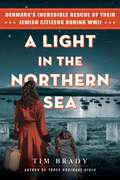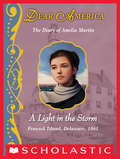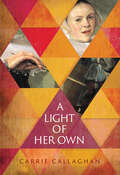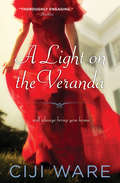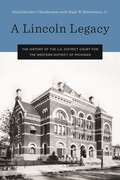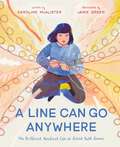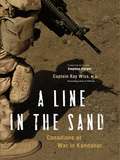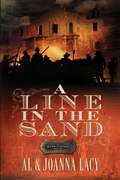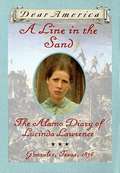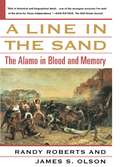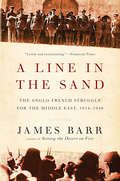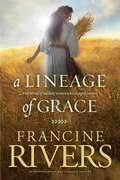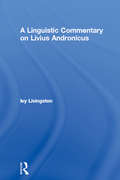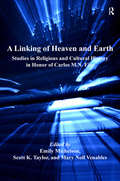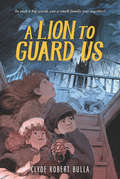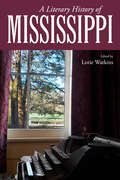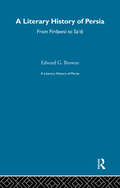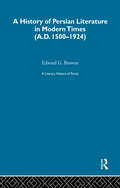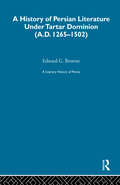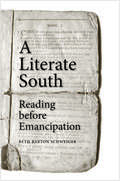- Table View
- List View
A Light in the Northern Sea: Denmark's Incredible Rescue of Their Jewish Citizens During WWII
by Tim BradyFrom the bestselling author of Three Ordinary Girls, the gripping, remarkably little-known true story of how the people of Denmark banded together during WWII to rescue nearly all of their Jewish citizens from Nazi persecution by ferrying them just a few at a time to sanctuary in Sweden. August 25, 1943. A lone bicyclist transports a cache of explosives, hidden in a beer crate, to a Copenhagen hall being readied to house German troops. In a violent blast, the would-be barracks is reduced to rubble. It&’s the boldest act yet of Holger Danske and the growing Danish resistance combating the oppressiveness of Hitler&’s Reich. In 1940, on its way to conquering Western Europe, Germany coerced the Danish government into a &“cooperative&” agreement that lasted three long years until the increasing brazenness of the Resistance movement prompted a crackdown. Denmark&’s nearly 8000 Jews, who had so far been spared Hitler&’s wrath, now became the focus of his rage. A roundup was ordered to begin on October 1st, 1943, the first day of the Jewish New Year. The only passage to safety was across the Oresund to Sweden. But no group existed to organize an escape. Until the last moment, Sweden didn&’t agree to allow the refugees into the country; and the strait between the two nations was swarming with Gestapo. What happened next was a miracle. 95% of Denmark&’s Jews survived the Holocaust, the highest percentage in Europe. Here are the riveting true accounts of ordinary Danes who, using their modest resources, wiles, remarkable courage, and camaraderie, quietly orchestrated their escape. Among them were Jorgen Kieler and his siblings, student activists galvanized by their sense that their government hadn&’t done enough to prevent the German takeover . . . Henny Sinding, the legendary &“Girl in the Red Hat&” . . . David Sampolinsky, an Orthodox Jew who teamed with a Lutheran school teacher to escort hundreds to safety . . . Niels Bohr, the world-famous nuclear physicist being rushed to help Oppenheimer build the bomb at Los Alamos, who paused on his way to safety to implore the King of Sweden to allow Danish refugees into his country. A work of World War II history that reads like a thriller, this inspiring chronicle examines why, unlike the rest of Western Europe, these accomplishments were so uniquely managed by the Danish people, even in the face of Nazi occupation and Hitler&’s growing fixation on the Final Solution.
A Light in the Storm: The Civil War Diary of Amelia Martin (Dear America)
by Karen HesseNewbery Medal winner Karen Hesse's Civil War diary, A LIGHT IN THE STORM, is now back in print with a beautiful new cover!In 1861, Amelia Martin's father is stripped of his post as a ship's captain when he is caught harboring the leader of a slave rebellion. Now he is an assistant lighthouse keeper on Fenwick Island, off the coast of Delaware -- a state wedged between the North and the South, just as Amelia is wedged between her warring parents. Amelia's mother blames her abolitionist husband for their living conditions, which she claims are taking a toll on her health. Amelia observes her mother's hate and her father's admiration for Abraham Lincoln. But slavery is the deeper issue separating the two sides. As the Civil War rages on, Amelia slowly learns that she cannot stop the fighting, but by keeping watch in the lighthouse each day, lighting the lamps, cleaning the glass, and rescuing victims of Atlantic storms, she can still make a difference.
A Light of Her Own
by Carrie CallaghanIn Holland 1633, a woman’s ambition has no place. Judith is a painter, dodging the law and whispers of murder to try to become the first woman admitted to the Haarlem painters guild. Maria is a Catholic in a country where the faith is banned, hoping to absolve her sins by recovering a lost saint’s relic. Both women’s destinies will be shaped by their ambitions, running counter to the city’s most powerful men, whose own plans spell disaster. A vivid portrait of a remarkable artist, A Light of Her Own is a richly-woven story of grit against the backdrop of Rembrandt and an uncompromising religion.Story behind the story . . .The trail of Judith Leyster’s career was so faint that only years after her death in 1660, collectors began attributing her few surviving paintings to other artists. She signed her work with only a beautiful, stylized monogram. Credit went to Frans Hals, Jan Miense Molenaer, and others. She would remain lost to history until 1893.
A Light on the Veranda
by Ciji WareWhen Daphne Duvallon left New Orleans in the middle of her own wedding and ran away to New York, she vowed never to return to the land of her ancestors. Now she has come back to the South, to Natchez, Mississippi, a city as mysterious and compelling as the ghostly voices that haunt Daphne's dreams. A hasty visit to play the harp at her brother's wedding becomes an unexpected rendezvous with destiny when she meets Simon Hopkins, a nationally renowned nature photographer with dark secrets of his own. For the first time in years Daphne knows what she wants--until shadows from another life that cannot forget or forgive threaten to silence the music in her life and destroy her only real chance for happiness.
A Lincoln Legacy: The History of the U.S. District Court for the Western District of Michigan (Great Lakes Books Series)
by David Gardner Chardavoyne Hugh W. JrA Lincoln Legacy: The History of the U.S. District Court for the Western District of Michigan by David Gardner Chardavoyne with Hugh W. Brenneman, Jr. provides the first and only comprehensive examination of the history of the United States federal courts in the Western District of Michigan. The federal courts were established by the U.S. Constitution to adjudicate disputes involving federal laws, disputes between litigants from different states involving state and federal laws, and to punish violations of criminal laws passed by Congress. During the Civil War, Abraham Lincoln signed legislation creating two federal districts in the state of Michigan: the Eastern and Western Districts—the latter of which is headquartered in Grand Rapids and which now encompasses the western half of the Lower Peninsula and all of the Upper Peninsula. With the rapid expansion of legislation passed by Congress, the increasing mobility of society, and the growth of interstate commerce, the federal courts have assumed an important and sometimes dominant role in major litigation today. In A Lincoln Legacy, Chardavoyne tracks the history of these courts over eleven chapters, from their creation by the Northwest Ordinance of 1787 to 2020. He discusses the changes in society that drove the evolving federal litigation and some significant cases heard in the Western District. Additionally, fifteen appendices are included in the book, listing of all the federal circuit and district judges in the Western District; commissioners; magistrate judges and bankruptcy judges; U.S. Attorneys; clerks of the courts; and more. Chardavoyne also identifies auxiliary offices and organizations revolving around the federal court that play a major role in its activities (e.g., the U.S. Attorney’s Office, the Federal Public Defender’s Office, the Federal Bar Association, etc.). A Lincoln Legacy provides a thorough examination of the history of the federal courts of Western Michigan. It will appeal to those learning and practicing law, as well as those with an interest in Michigan history.
A Line Can Go Anywhere: The Brilliant, Resilient Life of Artist Ruth Asawa
by Caroline McAlisterA sweeping picture book biography about influential Japanese-American sculptor Aiko Ruth Asawa and her childhood spent in an incarceration camp, by award-winning author Caroline McAlister and rising star artist Jamie Green.Growing up on a dusty farm in Southern California, Ruth Aiko Asawa lived between two worlds. She was Aiko to some and Ruth to others, an invisible line she balanced on every day.But when Japan bombed Pearl Harbor, suddenly she was only Aiko, no matter how much her family tried to cut the lines that connected them to Japan. Like many other Japanese Americans, Ruth and her family were sent to incarceration camps.At the Santa Anita racetrack, Ruth ran her fingers over the lines of horsehair in the stable stalls the family had moved into. At the Rohwer Relocation Center in Arkansas, she drew what she saw—bayous, guard towers, and the barbed wire that separated her from her old life.That same barbed wire would inspire Ruth’s art for decades, as she grew into one of the most influential artists of the twentieth century. Throughout her career, she created enchanting twisting sculptures and curving shapes that connected, divided, and intersected.This gorgeous biography delves into the magnificent life of Ruth Asawa and her timeless contributions to the art world.
A Line in the Sand
by Ray WissIn 2007-08, Dr. Ray Wiss, a former infantry officer, served with the Canadian Forces at forward operating bases in Khandahar's Panjwayi valley, the area experiencing the most intense combat in Afghanistan. He spent more time in the combat area than any other Canadian physician, and his successful first book, FOB Doc, was the diary of his time "outside the wire" during that tour of duty.Captain Wiss's experience in Afghanistan convinced him that this conflict was a rare example of a moral war. When asked to return for an even longer tour of duty in the combat zone, he readily agreed. Once again, he kept a diary, writing with passion about the efforts, sacrifices and achievements of those Canadians who served with such distinction. Illustrated with over 100 colour photographs, A Line in the Sand tells us about virtually every kind of soldier fighting in Afghanistan: the bomb technician, the engineer, the combat medic, the "grunt" as well as about the Afghans, from whom we are seemingly so different yet with whom we share so much. It is an impassioned insider's view of the war in Afghanistan and a convincing testament to why it matters.
A Line in the Sand (Kane Legacy #1)
by Al Lacy Joanna LacyThe Kane Legacy: faith, love, courage, and strength. In nineteenth-century Texas, they're going to need it. In 1835, Alan Kane and his family come to the Circle C Ranch in Texas, little dreaming what the future holds in both blessing and danger. Beautiful Julia Miller, daughter of a Louisiana plantation owner, has captured Alan's heart, but he hardly dares to hope for her hand. Then Colonel William Travis calls for the men of Texas to rally against Mexico's General Santa Anna. Full of honor and courage, brothers Alan and Adam join up with Jim Bowie to do their part. The plan centers on holding a Franciscan mission known as the Alamo and soon includes Davy Crockett and his Tennessee Mounted Volunteers. As battle looms, what is God's purpose for the Kane men? Can they share their eternal hope with men ready to die for Texas? Will brotherly bonds overcome a jealous secret in the face of death? And just what will endure of the Kane legacy? From the Trade Paperback edition.
A Line in the Sand: Britain, France and the struggle that shaped the Middle East
by James BarrIn 1916, in the middle of the First World War, two men secretly agreed to divide the Middle East between them. Sir Mark Sykes was a visionary politician; François Georges-Picot a diplomat with a grudge. The deal they struck, which was designed to relieve tensions that threatened to engulf the Entente Cordiale, drew a line in the sand from the Mediterranean to the Persian frontier. Territory north of that stark line would go to France; land south of it, to Britain. The creation of Britain's 'mandates' of Palestine, Transjordan and Iraq, and France's in Lebanon and Syria, made the two powers uneasy neighbours for the following thirty years. Through a stellar cast of politicians, diplomats, spies and soldiers, including T. E. Lawrence, Winston Churchill and Charles de Gaulle, A Line in the Sand vividly tells the story of the short but crucial era when Britain and France ruled the Middle East. It explains exactly how the old antagonism between these two powers inflamed the more familiar modern rivalry between the Arabs and the Jews, and ultimately led to war between the British and French in 1941 and between the Arabs and Jews in 1948. In 1946, after many years of intrigue and espionage, Britain succeeded in ousting France from Lebanon and Syria, and hoped that, having done so, it would be able to cling on to Palestine. Using newly declassified papers from the British and French archives, James Barr brings this clandestine struggle back to life, and reveals, for the first time, the stunning way in which the French finally got their revenge.
A Line in the Sand: The Alamo Diary of Lucinda Lawrence (Dear America)
by Sherry GarlandIn the journal she receives for her twelfth birthday in 1835, Lucinda Lawrence describes the hardships her family and other residents of the "Texas colonies" endure when they decide to face the Mexicans in a fight for their freedom.
A Line in the Sand: The Alamo in Blood and Memory
by Randy Roberts James S. OlsonIn late February and early March of 1836, the Mexican Army under the command of General Antonio López de Santa Anna besieged a small force of Anglo and Tejano rebels at a mission known as the Alamo. The defenders of the Alamo were in an impossible situation. They knew very little of the events taking place outside the mission walls. They did not have much of an understanding of Santa Anna or of his government in Mexico City. They sent out contradictory messages, they received contradictory communications, they moved blindly and planned in the dark. And in the dark early morning of March 6, they died. In that brief, confusing, and deadly encounter, one of America's most potent symbols was born. The story of the last stand at the Alamo grew from a Texas rallying cry, to a national slogan, to a phenomenon of popular culture and presidential politics. Yet it has been a hotly contested symbol from the first. Questions remain about what really happened: Did William Travis really draw a line in the sand? Did Davy Crockett die fighting, surrounded by the bodies of two dozen of the enemy? And what of the participants' motives and purposes? Were the Texans justified in their rebellion? Were they sincere patriots making a last stand for freedom and liberty, or were they a ragtag collection of greedy men-on-the-make, washed-up politicians, and backwoods bullies, Americans bent on extending American slavery into a foreign land? The full story of the Alamo -- from the weeks and months that led up to the fateful encounter to the movies and speeches that continue to remember it today -- is a quintessential story of America's past and a fascinating window into our collective memory. In A Line in the Sand, acclaimed historians Randy Roberts and James Olson use a wealth of archival sources, including the diary of José Enrique de la Peña, along with important and little-used Mexican documents, to retell the story of the Alamo for a new generation of Americans. They explain what happened from the perspective of all parties, not just Anglo and Mexican soldiers, but also Tejano allies and bystanders. They delve anew into the mysteries of Crockett's final hours and Travis's famous rhetoric. Finally, they show how preservationists, television and movie producers, historians, and politicians have become the Alamo's major interpreters. Walt Disney, John Wayne, and scores of journalists and cultural critics have used the Alamo to contest the very meaning of America, and thereby helped us all to "remember the Alamo."
A Line in the Sand: The Anglo-French Struggle for the Middle East, 1914-1948
by James Barr"A provocative history . . . helps us to understand why the Arab spring is so important and valuable."--David Ignatius, National Interest In the twentieth century, while fighting a common enemy in Europe, Britain and France were locked in a clandestine struggle for power in the Middle East. From the first agreement to divide the region between them to the birth of Israel, A Line in the Sand is a gripping narrative of the last gasp of imperialism, with tales of unscrupulous double-dealing, cynical manipulation, and all-too-frequent violence that continues to the present day.
A Lineage of Grace: Five Stories of Unlikely Women Who Changed Eternity
by Francine RiversBack Cover: This book consists of five expanded Biblical stories telling about the five women whom God chose. These Biblical women are in the lineage of Jesus Christ, the Savior of the world according to Christians and Messianic Jews. “TAMAR Betrayed by the men who controlled her future, she fought for her right to believe in a loving God. RAHAB A woman with a past to whom God gave a future. RUTH She gave up everything, expecting nothing, and God honored her. BATHSHEBA Her beauty stirred the passion of a king. Her pain moved the heart of God. MARY All eternity had been waiting for this moment. She responded in simple obedience to God's will. Each woman's story includes a six part Bible study, perfect for personal study or group discussion.”
A Linguistic Commentary on Livius Andronicus (Studies in Classics)
by Ivy LivingstonAs the oldest literary Latin preserved in any quantity, the language of Livius shows many features of linguistic interest and raises intriguing questions of phonolgy, morphology and syntax.
A Linguistic History of Ancient Cyprus
by Philippa M. SteeleThis pioneering volume approaches the languages and scripts of ancient Cyprus from an interdisciplinary point of view, with a primarily linguistic and epigraphic approach supplemented by a consideration of their historical and cultural context. The focus is on furthering our knowledge of the non-Greek languages/scripts, as well as appreciating their place in relation to the much better understood Greek language on the island. Following on from recent advances in Cypro-Minoan studies, these difficult, mostly Late Bronze Age inscriptions are reassessed from first principles. The same approach is taken for non-Greek languages written in the Cypriot Syllabic script during the first millennium BC, chiefly the one usually referred to as Eteocypriot. The final section is then dedicated to the Phoenician language, which was in use on Cyprus for some hundreds of years. The result is a careful reappraisal of these languages/scripts after more than a century of sometimes controversial scholarship.
A Linking of Heaven and Earth: Studies in Religious and Cultural History in Honor of Carlos M.N. Eire (St Andrews Studies in Reformation History)
by Scott K. TaylorThe Reformation of the sixteenth century shattered the unity of medieval Christendom, and the resulting fissures spread to the corners of the earth. No scholar of the period has done more than Carlos M.N. Eire, however, to document how much these ruptures implicated otherworldly spheres as well. His deeply innovative publications helped shape new fields of study, intertwining social, intellectual, cultural, and religious history to reveal how, lived beliefs had real and profound implications for social and political life in early modern Europe. Reflecting these themes, the volume celebrates the intellectual legacy of Carlos Eire's scholarship, applying his distinctive combination of cultural and religious history to new areas and topics. In so doing it underlines the extent to which the relationship between the natural and the supernatural in the early modern world was dynamic, contentious, and always urgent. Organized around three sections - 'Connecting the Natural and the Supernatural', 'Bodies in Motion: Mind, Soul, and Death' and 'Living One's Faith' - the essays are bound together by the example of Eire's scholarship, ensuring a coherence of approach that makes the book crucial reading for scholars of the Reformation, Christianity and early modern cultural history.
A Lion to Guard Us (A\trophy Bk Ser.)
by Clyde Robert BullaLeft on their own in seventeenth-century London, three impoverished children draw upon all their resources to stay together and make their way to the Virginia colony in search of their father.
A Literary Approach to the New Testament
by John Paul PritchardFrom the book: The literary approach views form and content as one and is concerned with what the book is. Just as the literary interpreter of Chaucer requires a wealth of information and insight concerning the times of Chaucer and the influences at work in him, so the literary interpreter of the New Testament requires information about it and insights into it. Knowing what the book is in itself and in its relations frequently clarifies significantly what the book means. General readers will profit from the presentation of this knowledge in developing their own insights into the New Testament. In asserting that the reader of the New Testament will find greater reward and understanding if he is a Christian, there is no intent to belittle the values of the book for non-Christian readers. Such readers should, however, exercise what Coleridge described as "the willing suspension of disbelief for a season" in order to enter, at least temporarily, into the spirit of the work. If we endeavor to read in this spirit, we shall find the work richer and more rewarding. For literary interpretation of the New Testament, the traditional Sunday school presentation has contributed little beyond acquainting children with episodes and agents. In it books are seldom treated as wholes made by an author with specific purpose and artistic designs. Books are to be analyzed upon sound anatomical principles for study of what they are before ideas for moral and religious instruction are drawn from them.
A Literary History of Mississippi (Heritage of Mississippi Series)
by Lorie WatkinsWith contributions by Ted Atkinson, Robert Bray, Patsy J. Daniels, David A. Davis, Taylor Hagood, Lisa Hinrichsen, Suzanne Marrs, Greg O'Brien, Ted Ownby, Ed Piacentino, Claude Pruitt, Thomas J. Richardson, Donald M. Shaffer, Theresa M. Towner, Terrence T. Tucker, Daniel Cross Turner, Lorie Watkins, and Ellen WeinauerMississippi is a study in contradictions. One of the richest states when the Civil War began, it emerged as possibly the poorest and remains so today. Geographically diverse, the state encompasses ten distinct landform regions. As people traverse these, they discover varying accents and divergent outlooks. They find pockets of inexhaustible wealth within widespread, grinding poverty. Yet the most illiterate, disadvantaged state has produced arguably the nation's richest literary legacy. Why Mississippi?What does it mean to write in a state of such extremes? To write of racial and economic relations so contradictory and fraught as to defy any logic? Willie Morris often quoted William Faulkner as saying, "To understand the world, you must first understand a place like Mississippi." What Faulkner (or more likely Morris) posits is that Mississippi is not separate from the world. The country's fascination with Mississippi persists because the place embodies the very conflicts that plague the nation.This volume examines indigenous literature, Southwest humor, slave narratives, and the literature of the Civil War. Essays on modern and contemporary writers and the state's changing role in southern studies look at more recent literary trends, while essays on key individual authors offer more information on luminaries including Faulkner, Eudora Welty, Richard Wright, Tennessee Williams, and Margaret Walker. Finally, essays on autobiography, poetry, drama, and history span the creative breadth of Mississippi's literature. Written by literary scholars closely connected to the state, the volume offers a history suitable for all readers interested in learning more about Mississippi's great literary tradition.
A Literary History of Persia
by E.G. BrowneBrowne's famous work, first published in 1902, was the essential text on literary history in Persian studies for many years. As an overview of Persian literature from the earliest times until Firdawsi, it continues to be a valuable reference. Out of print for some time, it is now reissued as a library edition, in facsimile to capture the feel of the original edition.
A Literary History of Persia: From The Earliest Times Until Firdawsi (Classics Of Iranian Studies #No. 1)
by E.G. BrowneBrowne's famous work, first published in 1902, was the essential text on literary history in Persian studies for many years. As an overview of Persian literature from the earliest times until Firdawsi, it continues to be a valuable reference. Out of print for some time, it is now reissued as a library edition, in facsimile to capture the feel of the original edition.
A Literary History of Persia: Modern Times (1500-1924)
by E.G. BrowneBrowne's famous work, first published in 1902, was the essential text on literary history in Persian studies for many years. As an overview of Persian literature from the earliest times until Firdawsi, it continues to be a valuable reference. Out of print for some time, it is now reissued as a library edition, in facsimile to capture the feel of the original edition.
A Literary History of Persia: The Tartar Dominion (1265-1502)
by E.G. BrowneBrowne's famous work, first published in 1902, was the essential text on literary history in Persian studies for many years. As an overview of Persian literature from the earliest times until Firdawsi, it continues to be a valuable reference. Out of print for some time, it is now reissued as a library edition, in facsimile to capture the feel of the original edition.
A Literary Holiday Cookbook: Festive Meals for the Snow Queen, Gandalf, Sherlock, Scrooge, and Book Lovers Everywhere
by Alison WalshFor fans of Little Women, The Chronicles of Narnia, A Christmas Carol, Alice's Adventures in Wonderland, and more, a literature-inspired cookbook for voracious readers during the festive holiday season. Some of the most famous instances of fictional fare have become synonymous with the holidays. Who can forget the plentiful food surrounding the Ghost of Christmas Present in A Christmas Carol? The simple but generous and joy-filled Christmas gatherings at the Marchs' in Little Women? Or the Van Tassel&’s autumnal feast in The Legend of Sleepy Hollow? Finally, these literary meals can become a reality on your table with A Literary Holiday Feast. From Christmas and Thanksgiving to Halloween and New Year's, this seasonal cookbook offers 17 full four-course holiday meals from 25 classic books—each including an appetizer, entrée, side dish, and dessert. Additionally, whip up festive sips and delectable edible gifts to share with loved ones. As you curl up by the fireplace to reread one of your favorite literary classics, learn to make:Mouse King Cheese Bites and Sugar Plums from The Nutcracker for ChristmasTurkey Roulade and Jo's Gingerbread from Little Women for ChristmasSkillet Cornbread with Homemade Butter and Venison Pot Roast from The Little House on the Prairie for ThanksgivingDeviled Raven Eggs and Coffin Pizza Pockets from Edgar Allen Poe for HalloweenThe Queen of Hearts Tomato Tart and Eat Me Cakes from Alice's Adventures in Wonderland for the New Yearand many more! Finally—whether you love Dracula, Phantom of the Opera, Redwall, or The Wonderful Wizard of Oz—book lovers can enjoy full menus of literary delicacies from their favorite books for all of their favorite holidays!
A Literate South: Reading before Emancipation
by Beth Barton SchweigerA provocative examination of literacy in the American South before emancipation, countering the long-standing stereotype of the South’s oral tradition Schweiger complicates our understanding of literacy in the American South in the decades just prior to the Civil War by showing that rural people had access to a remarkable variety of things to read. Drawing on the writings of four young women who lived in the Blue Ridge Mountains, Schweiger shows how free and enslaved people learned to read, and that they wrote and spoke poems, songs, stories, and religious doctrines that were circulated by speech and in print. The assumption that slavery and reading are incompatible—which has its origins in the eighteenth century—has obscured the rich literate tradition at the heart of Southern and American culture.
